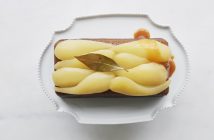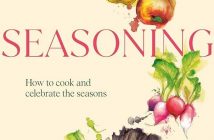The Arb’s own Mrs Beeton, Angela Clutton, continues her tutelage on the game season, and in a fitting accompaniment to the Jugged Hare, here she offers her tips on potting a rabbit…
The cooks of the first Elizabethan era loved a bit of potted meat. In their world, before fridges and kilner jars, its air-tight seal of clarified butter enabled them to store costly produce for a good few months. And so as we back-slap our way towards the end of a year which has celebrated how well the second Elizabethan era is going, it seems timely for us to each embrace our inner potter.
The game meats lend themselves particularly well to being potted. I’m doing rabbit here but think about trying partridge, grouse, duck, pigeon or hare too. The storing time allows the game’s depth of flavour to really develop and come out; and the fat which it partners with combats/complements the game’s typical dryness.
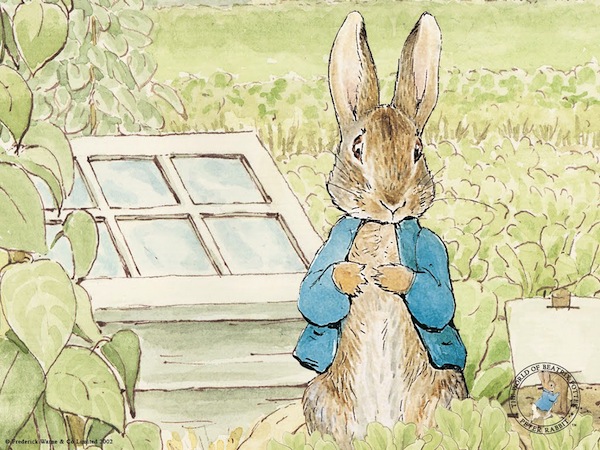
Rabbit is the most cross-seasonal of the game meats so you should be able to lay your hands on it pretty much all year round. Which is handy as this potted rabbit is equally triumphant in a summer picnic or as part of a rustled-up Christmas-time lunch alongside your gammon, cheese and maybe a nice slice of pork pie. That’s what the batch I just made is destined for.
In this recipe the rabbit is potted with belly pork and pancetta, and has flavours of juniper, cider and mustard for a real richness.
You will need:
- 1 jointed rabbit – my rabbit weighed 900g. Ask for the heart & livers too as they are extremely delicious, and chop them into small pieces.
- 450 g fatty pork belly, cut into 5cm cubes
- 70g pancetta or smoked bacon lardons
- 2 bay leaves
- 2 shallots – skinned and halved
- 1 stick celery – cut into four big pieces
- 2 garlic cloves – unpeeled
- 4 thyme sprigs
- 15 juniper berries – crushed
- large glass dry cider
- water
- 2 tsp dijon mustard
- 220g unsalted butter
Also, some equipment and utensils:
- large casserole pot with a lid
- large colander / sieve
- small sieve or tea-strainer
- square of muslin
- storage jars – for the quantities above you will need 1l worth of jars; I use 1 x 500ml and 2 x 250ml.
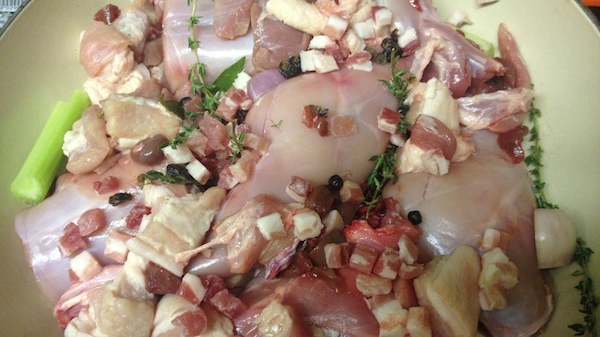
1. Make a bed of pork belly on the base of the casserole. Lay the rabbit meat on top and then the rest of the pork belly with the pancetta. Now tuck into and around all that meat your bay leaves, shallots, celery, garlic, thyme and juniper. Pour over the cider and then enough water to just about cover the meat. Bring to a high simmer, turn the heat right down low and put the lid on.
Those of us who are used to sealing meat over a high heat at the beginning of almost every recipe may have to fight the compunction to do that here too. But this method calls for the fat to eventually disintegrate into the meat and if you have crisped it up first then it just won’t.
2. Leave the pot on a low simmer for two hours, checking part way through that it is not drying out but otherwise resisting the temptation to sneak a peek and see what is going on. After two hours turn the heat off but do not lift the lid. Leave it alone for another half hour. Set your colander or large sieve over a saucepan and strain everything from the casserole into it. You will need the cooking liquid later.
 3. Let it cool down for a couple of minutes before you begin the process of steadily separating it all out. The rabbit meat will be very tender and falling off the bone in places. Pull the pieces off and as you put them into a large mixing bowl shred the meat with your fingers. Strip the fat off the pork belly and put into the pestle; tear at the pork meat and add to the rabbit. Your pieces of pancetta join the other meat and they’ll be so tender from the way you’ve cooked them that as you press the pancetta between your fingertips it’ll just melt. Likewise the liver and heart. Discard the bay leaves, shallots, celery, garlic, thyme and juniper as you go.
3. Let it cool down for a couple of minutes before you begin the process of steadily separating it all out. The rabbit meat will be very tender and falling off the bone in places. Pull the pieces off and as you put them into a large mixing bowl shred the meat with your fingers. Strip the fat off the pork belly and put into the pestle; tear at the pork meat and add to the rabbit. Your pieces of pancetta join the other meat and they’ll be so tender from the way you’ve cooked them that as you press the pancetta between your fingertips it’ll just melt. Likewise the liver and heart. Discard the bay leaves, shallots, celery, garlic, thyme and juniper as you go.
4. Use your hands to mix all the meats together – again pulling and pressing at the meat to get the consistency you want. And it is your choice. I like a coarse texture where I can see the meat but if something smoother is more to your taste then put it all through your food processor.
5. The belly fat needs to be pounded to a paste. Throw away any stubborn pieces that refuse to mush – nobody wants to find a lump of fat in their potting. Mix the fat through the meat.
6. Now add the mustard and a ladleful of the cooking stock. You will probably need more liquid to get the consistency you want but add it in stages. Have a taste and season as you think fit.
7. Pack the meat into sterilised jars, pressing it down with the back of a spoon to eliminate any air pockets. Go up to about half an inch off the top of the jar.
8. Now for the air-tight seal of clarified butter. This might sound like a faff, but clarifying the butter gets rid of its salt, buttermilk and other impurities. When you see all the icky white scum that comes off it I bet you’ll be glad you bothered.
Melt the butter over a very very low heat. As that is happening, pour boiling water over the muslin, lay it into the sieve and set the sieve over a small jug. Let the melted butter stand off the heat for a couple of minutes and then run it through the muslin sieve.
9. Once strained, pour the butter over the top of each jar of meat. It should be at least half a centimetre thick but more is fine. Put the lids on and rejoice in the fact that as you have very cleverly created your own air-tight seal you won’t have a sleepless night wondering if you did the Kilner properly.
Store your potted meats in the fridge and don’t eat for at least a week. They will keep happily for a couple of months but once the seal has been broken you should use it up within a couple of days.
Always bring the potted meat to room temperature before serving. That way it will be a good consistency for spreading thickly onto walnut toast. I’ll be enjoying mine with a nice glass of red wine – or maybe a drop of ale.
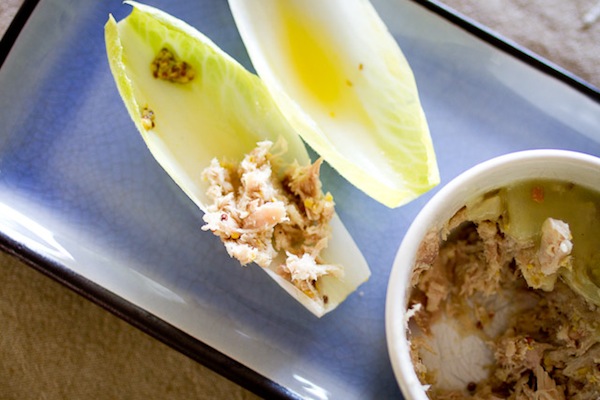
Angela Clutton is writing a book about all kinds of ways of living and doing things that have been passed down through generations. For more information, visit her website.


